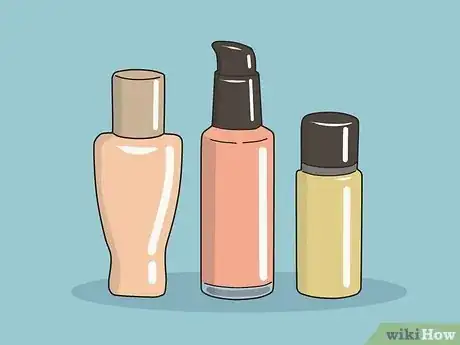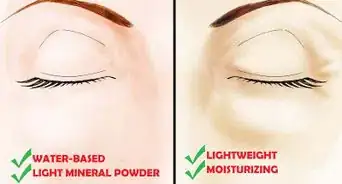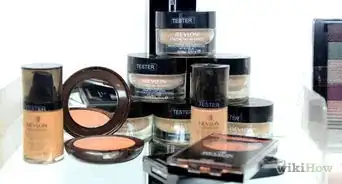This article was co-authored by Devorah Kuperland. Devorah Kuperland is a Makeup Artist and the Founder of Glam By Dev, a New York City-based business specializing in bridal, special events, and editorial campaigns. Devorah has over five years of professional makeup consulting experience and her work has been featured in New York's Bridal Fashion Week.
There are 9 references cited in this article, which can be found at the bottom of the page.
This article has been viewed 40,960 times.
Honey toned skin is a beautiful color with plenty of depth. It can be difficult to pinpoint your perfect foundation as your skin take on several different shades when in different lighting. Examine the skin on your face closely to properly identify what colors can make up the right foundation for you.
Steps
Knowing your Skin
-
1Discover your skin type. Think about what words you would use to describe your skin: oily, dry, acne-prone, sensitive.[1] Look for foundation formulas that will cater to your skin type. If you have oily skin, getting an oil-free foundation will be a sure way to keep your foundation from sliding off your face.[2]
- For instance, if you have oily skin, you'll notice that your face might look shiny in your T-zone area, which is across your forehead and down to your chin.[3]
- It is possible to have a combination skin type. If you find that some of your skin is oily and other parts always need more moisturizer, you likely have combination skin.
-
2Know your undertone. Undertone is your skin's natural inclination toward pink or yellow. Some skin may be a blend of both (neutral), but more often than not you are one or the other. Honey is a yellow undertone.[4]
- The easiest way to determine your undertone is to look at the veins on your wrist. If they look green or olive, your undertones are yellow. If they look blue, your undertones are pink.[5]
- If you still can’t tell your undertone, hold up a white piece of paper to your face. Determine if you seem more yellow, or more pink, compared to the paper. This is your undertone.
- Undertone never changes, no matter how much you tan.
Advertisement -
3Match your foundation to your lifestyle. If you are in an office all day you’ll have different foundation needs than if you’re outside sweating in the sun. Think about your lifestyle and determine what needs you want met by your foundation.
- Perhaps you are a landscaper and you want long lasting coverage. Alternatively, you may need a foundation that will be great for a few hours during a photography session.[6]
- Try using a matte primer underneath your foundation to make it last longer and help even out your skin tone.[7]
- In addition, you can use a concealer to cover up any smaller areas, like blemishes or dark circles under your eyes.[8]
Getting the Right Foundation
-
1Get the right coverage. Knowing your skin type will help you identify the product and coverage you need. If you have dry skin and need more coverage, try a liquid or moisturizing powder foundation.[9] When you have combination skin, strategically apply powder foundation and liquid foundation with careful blending.[10]
-
2Choose the correct shade. To choose the correct shade, you need to swatch your skin with foundation. While in the beauty store, pick a number of shades that look close to your skin tone. Apply a small amount by dabbing with your finger. Give the sample twenty minutes to absorb and set.[13] Look at it again. If the sample has disappeared, it’s a perfect match.
- It was previously believed the best place to test foundation was on your wrist. This is incorrect, and it is more accurate to test your foundation on your neck or jawline if possible.[14]
- Your skin tone will likely change throughout the year. Rather than buying a new bottle, try mixing colors to get the perfect shade, or adding a drop of moisturizer to lighten your color.
- Go for a tone in between the matching of your cheeks and forehead. Matching the larger zones of your face with the more eye-catching areas will ensure you purchase the correct shade.
-
3Experiment with different brands and colors. With your honey skin, it may take some time to find the right foundation for you. Don’t get discouraged and be open to experimentation.
Expert Q&A
-
QuestionHow can someone tell if they have oily skin?
 Devorah KuperlandDevorah Kuperland is a Makeup Artist and the Founder of Glam By Dev, a New York City-based business specializing in bridal, special events, and editorial campaigns. Devorah has over five years of professional makeup consulting experience and her work has been featured in New York's Bridal Fashion Week.
Devorah KuperlandDevorah Kuperland is a Makeup Artist and the Founder of Glam By Dev, a New York City-based business specializing in bridal, special events, and editorial campaigns. Devorah has over five years of professional makeup consulting experience and her work has been featured in New York's Bridal Fashion Week.
Makeup Artist You can tell if you have oily skin if you notice oil being produced on different areas of your face. For instance, you'll often see your skin looking shiny or oily along your T-zone area, which is from your forehead across, and down to your chin.
You can tell if you have oily skin if you notice oil being produced on different areas of your face. For instance, you'll often see your skin looking shiny or oily along your T-zone area, which is from your forehead across, and down to your chin. -
QuestionHow do I choose the right foundation for porcelain-toned skin?
 HumanBeingTop AnswererIf you are lucky enough to have lovely porcelain-toned skin, skipping foundation is an option. Keep your skin in good condition by cleansing, toning and moisturizing. Search online for the recommendations of others with pale skin regarding foundation if you want to use some. Visit a department store makeup department and speak to the staff working at the makeup counter, who can advise you (remember, you're not obliged to buy what they suggest).
HumanBeingTop AnswererIf you are lucky enough to have lovely porcelain-toned skin, skipping foundation is an option. Keep your skin in good condition by cleansing, toning and moisturizing. Search online for the recommendations of others with pale skin regarding foundation if you want to use some. Visit a department store makeup department and speak to the staff working at the makeup counter, who can advise you (remember, you're not obliged to buy what they suggest). -
QuestionWhat's the difference between honey beige and sable?
 Community AnswerSable is darker than honey beige. Do a google image search for both and you'll see the difference.
Community AnswerSable is darker than honey beige. Do a google image search for both and you'll see the difference.
References
- ↑ http://www.fitnessmagazine.com/beauty/makeup/makeup-foundation-tips/?page=3
- ↑ http://www.fitnessmagazine.com/beauty/makeup/makeup-foundation-tips/?page=3
- ↑ Devorah Kuperland. Makeup Artist. Personal interview. 7 May 2020.
- ↑ https://www.youtube.com/watch?v=3XhItCiJ21I
- ↑ http://stylecaster.com/cool-warm-skin-undertones/
- ↑ http://www.seventeen.com/beauty/beauty-quizzes/a22549/makeup-base-quiz/
- ↑ Devorah Kuperland. Makeup Artist. Personal interview. 7 May 2020.
- ↑ Devorah Kuperland. Makeup Artist. Personal interview. 7 May 2020.
- ↑ www.oprah.com/style/How-to-Choose-and-Use-the-Right-Foundation
- ↑ www.oprah.com/style/How-to-Choose-and-Use-the-Right-Foundation
- ↑ http://cincovidas.com/foundation-101-cream-liquid-or-powder-what-your-skin-needs-during-chemotherapy/
- ↑ http://cincovidas.com/foundation-101-cream-liquid-or-powder-what-your-skin-needs-during-chemotherapy/
- ↑ http://www.fitnessmagazine.com/beauty/makeup/makeup-foundation-tips/?page=4
- ↑ http://www.fitnessmagazine.com/beauty/makeup/makeup-foundation-tips/?page=4
- ↑ http://stylecaster.com/beauty-high/how-to-choose-drugstore-foundation/
- ↑ http://www.fitnessmagazine.com/beauty/makeup/makeup-foundation-tips/?page=4































































